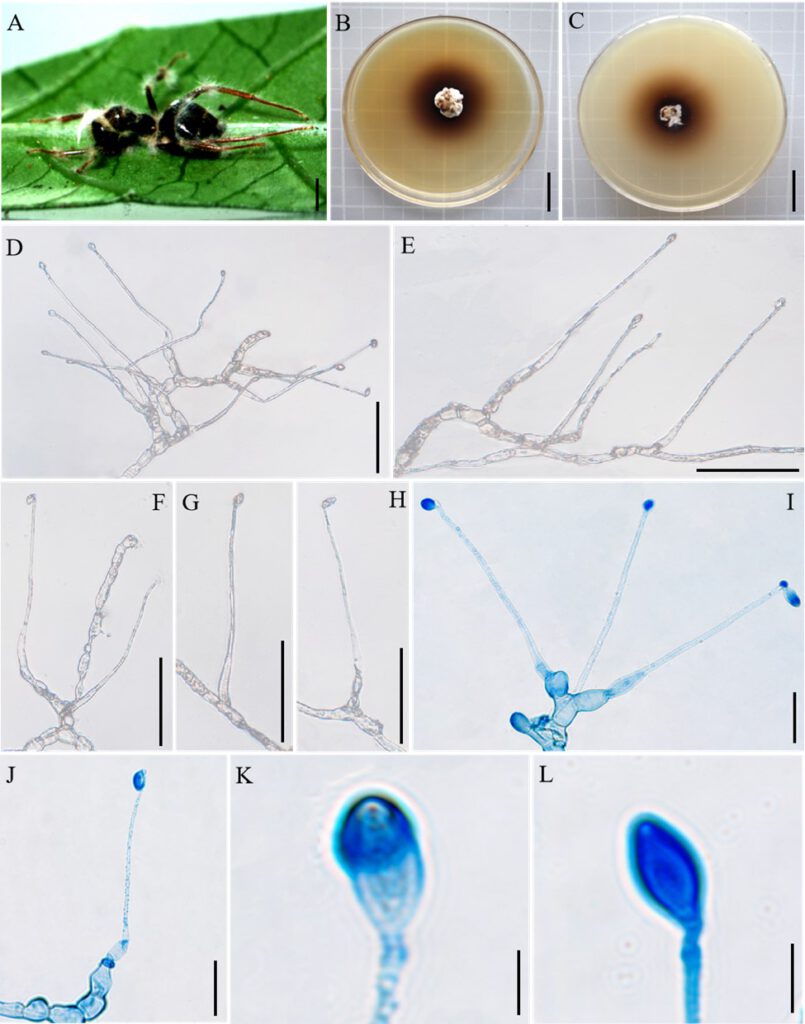Ophiocordyceps subtiliphialides H. Yu & D.X. Tang.
MycoBank number: MB; Index Fungorum number: IF; Facesoffungi number: FoF 11710;
Description
Subtropical monsoon evergreen broad-leaf forest. Camponotus sp. infected and biting the main vein of a leaf. Dying in the lower position, collected from 0.5 m to 1 m. Sexual state: External mycelium produced from the sutures and joints of the ant, producing one bud of the stroma at the head of the ant, flaky-shape, white. Sexual morphs were not observed. Asexual state: Colonies grew slowly on PDA medium, 19–20 mm diameter in 60 days at 25 C, milky white and light brown, raising cottony-shaped mycelial density at the edge, protuberant mycelial light brow at the centrum, reverse light brown to dark brown, the hyphae immersed in the medium were milky white. Hyphae branched, septate, smooth-walled, hyaline. Hirsutella type-B and Hirsutella type-C were observed. Conidiophores rare, cylindrical, produced from the hyphae, septate, short and wide. Phialides monophialidic or rarely polyphialidic, forming on side hyphae or the conidiophores, smooth, slight swollen base, lageniform, septate, tapering gradually a slender neck, slight bending, 70–124 × 1–3 µm. Conidia olivary, solitary, hyaline, smooth-walled, 6–9 × 4–7 µm.
Material examined: CHINA, Camponotus sp. infected and biting the leaves of tree seedlings, 18 August 2020, H. Yu (YHH 20139, neotype).
Distribution: Puer City, Yunnan Province, China
Sequence data: LSU: ON555914 (LROR/LR5); SSU: ON555833 (NS1/NS4); EF1a: ON567753 (983F/2218R); RPB1: ON568673 (RPB1/RPB1Cr_oph); RPB2: ON568126 (fRPB2-5F/fRPB2-7cR)
Notes: Phylogenetic analyses showed that four samples of O. subtiliphialides clustered together, with high statistical support (PP = 97%; BP = 96%), formed a separate clade in the O. unilateralis core clade of Southeast Asian countries. It was similar to O. septa, O. acroascus and O. basiascus in the behavior of the host biting a leaf, conidiogenous cell monophialidic, swollen base, lageniform. However, it differs from O. septa, O. acroascus and O. basiascus by conidiophores rare, phialides monophialidic or rarely polyphialidic, tapering a narrow and slender neck, conidia olivary, in addition, the size of phialides and conidia also differed from O. septa, O. acroascus and O. basiascus.

Fig. 4. Ophiocordyceps subtiliphialides (YHH 20139). A. Camponotus sp. infected and biting the main vein of a leaf. B-C. Colonies on PDA medium. D-H: Phialides and conidia. I: Conidiophores and phialides. J: Phialides. K-L: Conidia. Scale bars: A = 0.2 cm; B-C = 2 cm; D-H = 50 µm; I-J = 20 µm; K-L = 5 µm.
